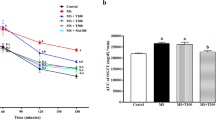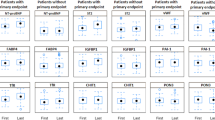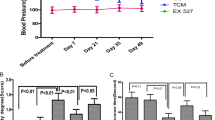Abstract
This study investigated the effects of rosiglitazone on nutritionally programmed chronic disease, with a focus on blood pressure (BP) and aortic wall structural remodeling. Wistar pregnant rats were fed one of two diets: a normal protein diet (19% protein; NP rats) or low-protein diet (5% protein; LP rats). Male offspring at 3 months of age were randomly divided into four groups: NP offspring treated with rosiglitazone (NPR); untreated NP offspring (NP); LP offspring treated with rosiglitazone (LPR); untreated LP offspring (LP). Rosiglitazone was administered at a dose of 5 mg/kg/d until 6 months of age. BP was elevated in LP offspring. Rosiglitazone reduced BP beginning in the first week of treatment in the LPR offspring. The insulin sensitivity was increased in LP offspring, and was not altered by rosiglitazone. LP offspring exhibited a 40% reduction in the amount of elastic fibers in the aorta wall compared with NP offspring (p<0.01), and the quantity of elastic fibers was not altered by rosiglitazone. The smooth muscle cells, elastic lamellae, circumferential wall tension (CWT) and tensile stress (TS) were increased in LP offspring, indicating increased blood flow in the aorta. Rosiglitazone reduced both CWT and TS by 30% compared to the levels in untreated LP offspring (p<0.01 for both). Rosiglitazone restored the expressions of angiotensin II type 1 receptor and endothelial nitric oxide synthase nearly to the levels in the NP offspring. ANOVA disclosed a significant two-factor interaction between protein content in the diet and rosiglitazone treatment (p<0.001 for CWT and p<0.00001 for TS, two-way ANOVA). We conclude that rosiglitazone has beneficial effects in reducing the BP and the aortic tunica media hypertrophy with consequent balance of the wall stress in metabolically programmed offspring.
Similar content being viewed by others
Article PDF
References
Gallou-Kabani C, Junien C : Nutritional epigenomics of metabolic syndrome: new perspective against the epidemic. Diabetes 2005; 54: 1899–1906.
Zandi-Nejad K, Luyckx VA, Brenner BM : Adult hypertension and kidney disease: the role of fetal programming. Hypertension 2006; 47: 502–508.
Heywood WE, Mian N, Milla PJ, Lindley KJ : Programming of defective rat pancreatic beta-cell function in offspring from mothers fed a low-protein diet during gestation and the suckling periods. Clin Sci (Lond) 2004; 107: 37–45.
Bonora E : The metabolic syndrome and cardiovascular disease. Ann Med 2006; 38: 64–80.
Olivetti G, Melissari M, Marchetti G, Anversa P : Quantitative structural changes of the rat thoracic aorta in early spontaneous hypertension. Tissue composition, and hypertrophy and hyperplasia of smooth muscle cells. Circ Res 1982; 51: 19–26.
Safar ME, London GM, Asmar R, Frohlich ED : Recent advances on large arteries in hypertension. Hypertension 1998; 32: 156–161.
Bouvet C, Gilbert LA, Girardot D, deBlois D, Moreau P : Different involvement of extracellular matrix components in small and large arteries during chronic NO synthase inhibition. Hypertension 2005; 45: 432–437.
Lehmann JM, Moore LB, Smith-Oliver TA, Wilkison WO, Willson TM, Kliewer SA : An antidiabetic thiazolidinedione is a high affinity ligand for peroxisome proliferator-activated receptor gamma (PPAR gamma). J Biol Chem 1995; 270: 12953–12956.
Granberry MC, Fonseca VA : Cardiovascular risk factors associated with insulin resistance: effects of oral antidiabetic agents. Am J Cardiovasc Drugs 2005; 5: 201–209.
Brunani A, Caumo A, Graci S, Castagna G, Viberti G, Liuzzi A : Rosiglitazone is more effective than metformin in improving fasting indexes of glucose metabolism in severely obese, non-diabetic patients. Diabetes Obes Metab 2008; 10: 460–467.
Negro R, Mangieri T, Dazzi D, Pezzarossa A, Hassan H : Rosiglitazone effects on blood pressure and metabolic parameters in nondipper diabetic patients. Diabetes Res Clin Pract 2005; 70: 20–25.
Ryan MJ, Didion SP, Mathur S, Faraci FM, Sigmund CD : PPAR(gamma) agonist rosiglitazone improves vascular function and lowers blood pressure in hypertensive transgenic mice. Hypertension 2004; 43: 661–666.
Reeves PG, Nielsen FH, Fahey GC Jr : AIN-93 purified diets for laboratory rodents: final report of the American Institute of Nutrition ad hoc writing committee on the reformulation of the AIN-76A rodent diet. J Nutr 1993; 123: 1939–1951.
Langley-Evans SC, Gardner DS, Jackson AA : Maternal protein restriction influences the programming of the rat hypothalamic-pituitary-adrenal axis. J Nutr 1996; 126: 1578–1585.
Quinn R : Comparing rat's to human's age: how old is my rat in people years? Nutrition 2005; 21: 775–777.
Fullmer HM, Lillie RD : A selective stain for elastic tissue (orcinol-new fuchsin). Stain Technol 1956; 31: 27–29.
Carallo C, Irace C, Pujia A, et al: Evaluation of common carotid hemodynamic forces. Relations with wall thickening. Hypertension 1999; 34: 217–221.
Mandarim-de-Lacerda CA : Stereological tools in biomedical research. An Acad Bras Cienc 2003; 75: 469–486.
Pires KMP, Aguila MB, Mandarim-de-Lacerda CA : Early renal structure alteration in rat offspring from dams fed low protein diet. Life Sci 2006; 79: 2128–2134.
Ozanne SE : Metabolic programming in animals. Br Med Bull 2001; 60: 143–152.
Souza-Mello V, Mandarim-de-Lacerda CA, Aguila MB : Hepatic structural alteration in adult programmed offspring (severe maternal protein restriction) is aggravated by post-weaning high-fat diet. Br J Nutr 2007; 98: 1159–1169.
Brawley L, Itoh S, Torrens C, et al: Dietary protein restriction in pregnancy induces hypertension and vascular defects in rat male offspring. Pediatr Res 2003; 54: 83–90.
Langley-Evans SC : Intrauterine programming of hypertension in the rat: nutrient interactions. Comp Biochem Physiol A Physiol 1996; 114: 327–333.
Nissen SE, Wolski K : Effect of rosiglitazone on the risk of myocardial infarction and death from cardiovascular causes. N Engl J Med 2007; 356: 2457–2471.
Home PD, Pocock SJ, Beck-Nielsen H, et al: Rosiglitazone evaluated for cardiovascular outcomes—an interim analysis. N Engl J Med 2007; 357: 28–38.
Krall RL : Cardiovascular safety of rosiglitazone. Lancet 2007; 369: 1995–1996.
Yue TL, Bao W, Gu JL, et al: Rosiglitazone treatment in Zucker diabetic Fatty rats is associated with ameliorated cardiac insulin resistance and protection from ischemia/reperfusion-induced myocardial injury. Diabetes 2005; 54: 554–562.
Molavi B, Chen J, Mehta JL : Cardioprotective effects of rosiglitazone are associated with selective over-expression of type 2 angiotensin receptors and inhibition of P42/44 MAPK. Am J Physiol Heart Circ Physiol 2006; 291: H687–H693.
Gonon AT, Bulhak A, Labruto F, Sjoquist PO, Pernow J : Cardioprotection mediated by rosiglitazone, a peroxisome proliferator−activated receptor gamma ligand, in relation to nitric oxide. Basic Res Cardiol 2007; 102: 80–89.
Bezie Y, Lacolley P, Laurent S, Gabella G : Connection of smooth muscle cells to elastic lamellae in aorta of spontaneously hypertensive rats. Hypertension 1998; 32: 166–169.
Skilton MR, Gosby AK, Wu BJ, et al: Maternal undernutrition reduces aortic wall thickness and elastin content in offspring rats without altering endothelial function. Clin Sci (Lond) 2006; 111: 281–287.
Giummelly P, Lartaud-Idjouadiene I, Marque V, et al: Effects of aging and antihypertensive treatment on aortic internal diameter in spontaneously hypertensive rats. Hypertension 1999; 34: 207–211.
Van Vre EA, van Beusekom HM, Vrints CJ, Bosmans JM, Bult H, Van der Giessen WJ : Stereology: a simplified and more time-efficient method than planimetry for the quantitative analysis of vascular structures in different models of intimal thickening. Cardiovasc Pathol 2007; 16: 43–50.
Woods LL, Ingelfinger JR, Nyengaard JR, Rasch R : Maternal protein restriction suppresses the newborn renin-angiotensin system and programs adult hypertension in rats. Pediatr Res 2001; 49: 460–467.
Yzydorczyk C, Gobeil F Jr, Cambonie G, et al: Exaggerated vasomotor response to ANG II in rats with fetal programming of hypertension associated with exposure to a low-protein diet during gestation. Am J Physiol Regul Integr Comp Physiol 2006; 291: R1060–R1068.
Benkirane K, Viel EC, Amiri F, Schiffrin EL : Peroxisome proliferator−activated receptor gamma regulates angiotensin II−stimulated phosphatidylinositol 3-kinase and mitogen-activated protein kinase in blood vessels in vivo. Hypertension 2006; 47: 102–108.
Benkirane K, Amiri F, Diep QN, El Mabrouk M, Schiffrin EL : PPAR-gamma inhibits ANG II-induced cell growth via SHIP2 and 4E-BP1. Am J Physiol 2006; 290: H390–H397.
Molavi B, Chen J, Mehta JL : Cardioprotective effects of rosiglitazone are associated with selective overexpression of type 2 angiotensin receptors and inhibition of p42/44 MAPK. Am J Physiol 2006; 291: H687–H693.
Erbe DV, Gartrell K, Zhang YL, et al: Molecular activation of PPARgamma by angiotensin II type 1−receptor antagonists. Vascul Pharmacol 2006; 45: 154–162.
Harte A, McTernan P, Chetty R, et al: Insulin-mediated upregulation of the renin angiotensin system in human subcutaneous adipocytes is reduced by rosiglitazone. Circulation 2005; 111: 1954–1961.
Zhou MS, Schulman IH, Raij L : Nitric oxide, angiotensin II, and hypertension. Semin Nephrol 2004; 24: 366–378.
Maejima Y, Adachi S, Morikawa K, Ito H, Isobe M : Nitric oxide inhibits myocardial apoptosis by preventing caspase-3 activity via S-nitrosylation. J Mol Cell Cardiol 2005; 38: 163–174.
do Carmo Pinho Franco M, Nigro D, Fortes ZB, et al: Intrauterine undernutrition—renal and vascular origin of hypertension. Cardiovasc Res 2003; 60: 228–234.
Franco Mdo C, Arruda RM, Dantas AP, et al: Intrauterine undernutrition: expression and activity of the endothelial nitric oxide synthase in male and female adult offspring. Cardiovasc Res 2002; 56: 145–153.
Polikandriotis JA, Mazzella LJ, Rupnow HL, Hart CM : Peroxisome proliferator−activated receptor gamma ligands stimulate endothelial nitric oxide production through distinct peroxisome proliferator−activated receptor gamma−dependent mechanisms. Arterioscler Thromb Vasc Biol 2005; 25: 1810–1816.
De Ciuceis C, Amiri F, Iglarz M, Cohn JS, Touyz RM, Schiffrin EL : Synergistic vascular protective effects of combined low doses of PPARalpha and PPARgamma activators in angiotensin II−induced hypertension in rats. Br J Pharmacol 2007; 151: 45–53.
Wang S, Jiang JL, Hu CP, Zhang XJ, Yang DL, Li YJ : Relationship between protective effects of rosiglitazone on endothelium and endogenous nitric oxide synthase inhibitor in streptozotocin-induced diabetic rats and cultured endothelial cells. Diabetes Metab Res Rev 2007; 23: 157–164.
Diep QN, El Mabrouk M, Cohn JS, et al: Structure, endothelial function, cell growth, and inflammation in blood vessels of angiotensin II−infused rats: role of peroxisome proliferator−activated receptor-gamma. Circulation 2002; 105: 2296–2302.
Iglarz M, Touyz RM, Viel EC, et al: Peroxisome proliferator−activated receptor-alpha and receptor-gamma activators prevent cardiac fibrosis in mineralocorticoid-dependent hypertension. Hypertension 2003; 42: 737–743.
Gao DF, Niu XL, Hao GH, et al: Rosiglitazone inhibits angiotensin II−induced CTGF expression in vascular smooth muscle cells—role of PPAR-gamma in vascular fibrosis. Biochem Pharmacol 2007; 73: 185–197.
Author information
Authors and Affiliations
Corresponding author
Rights and permissions
About this article
Cite this article
Torres, T., D'oliveira Silva, G., Aguila, M. et al. Effects of Rosiglitazone (a Peroxysome Proliferator−Activated Receptor γ Agonist) on the Blood Pressure and Aortic Structure in Metabolically Programmed (Perinatal Low Protein) Rats. Hypertens Res 31, 965–975 (2008). https://doi.org/10.1291/hypres.31.965
Received:
Accepted:
Issue date:
DOI: https://doi.org/10.1291/hypres.31.965
Keywords
This article is cited by
-
Maternal caffeine administration leads to adverse effects on adult mice offspring
European Journal of Nutrition (2013)



